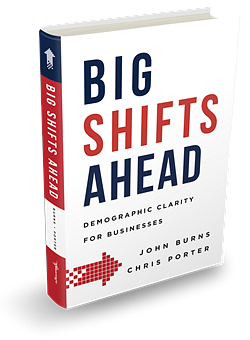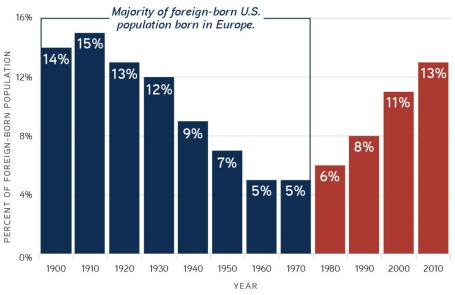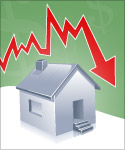 Sweeping changes in the nation’s demographic makeup will have profound effects on the nation’s housing industry, according to “Big Shifts Ahead: Demographic Clarity for Businesses,” a new book by authors John Burns and Chris Porter.
Sweeping changes in the nation’s demographic makeup will have profound effects on the nation’s housing industry, according to “Big Shifts Ahead: Demographic Clarity for Businesses,” a new book by authors John Burns and Chris Porter.
They argue that broad demographic shifts will reshape housing in America in the next decade, creating new opportunities for businesses of all kinds. Rising numbers of female executives, affluent immigrants, growing numbers of younger and older workers and a ballooning retiree population will have a profound influence on residential real estate in the U.S. over the next 10 years, according to Burns and Porter.
Generations By Decade
The book is organized into three sections. In part one — titled “Generations By Decade” — the authors outline one of the main frameworks of the book; renaming generational groups. They break down the generations in a novel and interesting way. Burns and Porter group the U.S. population by the decade they were born, rather than by generational groupings, i.e., Baby Boomers, Millennials or Gen-X.
For example, the duo calls Baby Boomers the Innovators because their generation has created so many innovations.

The authors see a retiree surge among the Innovators. Only 10 years ago, 2.2 million people were turning 65 each year. That number has surged to 3.5 million in 2016 and will grow to 4.2 million in 2025. These aging Innovator retirees will completely transform housing, argue Burns and Porter.
Born in the 1970s to dual-income and divorced parents, Balancers are teens who embraced television and video games. Unlike their workaholic parents, Balancers divorce less, stay home with
their kids more and have children later in life. One-third of Balancers are foreign born.
Next in the generational grouping are the Sharers. Born in the 1980s, the Sharers invented the sharing economy out of necessity, embracing new technologies. They are the most educated cohort ever, but they are racked by student debt, under-employment, and 20 percent live below the poverty line.
Raised by a single parent and born in the 1990s, the Connectors are wirelessly connected 24/7 to friends, family and the knowledge economy. Many Connectors are still in school; they are highly educated, underemployed and wary of credit.
4 Big Influencers
Next, Burns and Porter identify 4 Big Influencers that shape generational shifts, namely government policies, economic cycles, new technologies and societal shifts.
In part two — titled “The Biggest Demographic Opportunities” — they outline four big shifts impacting society, including the growth of college-educated women, new streams of affluent immigrants, workaholic retirees and young adults born after 1980 — the Sharers and the Connectors — who will dominate the next decade.
“We wrote Big Shifts Ahead primarily for ourselves,” writes Burns and Porter in the introduction. “As consultants to the construction and investment industries, we need to understand the demographic shifts transforming the country. We also need to communicate the trends to our clients in a way that makes the information digestible and usable for decision making.”
In part three — titled “Lifestyle Shifts” — they chronicle other trends, including the growth of the sharing economy, the migration southward and the new “surban” way of life. They believe people and millions of jobs will move from north to south. Americans will migrate south, leaving New York, Pennsylvania and Illinois to the Sunbelt states of Texas and Florida, seeking affordable housing and urban-like environments they call “surban” living.
“Surban” Living
In Chapter 10, the authors claim that surban living — a blend of the best of urban living with a more affrdable suburban environment — will see the bulk of new household formation in the next decade. They present evidence of a denser, more urban vision of suburbia that is powered by social and demographic shifts involving working women, affluent immigrants and both younger and older adults.
Along the way, they also make several 21st century forecasts, including some unexpected ones:
Rising rental rates: Burns and Porter see a soaring demand for rental units, especially since home ownership rates have declined from 69.2 percent in 2004 to 62.9 percent today. The sharing economy’s de-emphasis on home-ownership will be reflected in soaring demand for rental units. By 2025, home ownership rates are anticipated to drop to 60.8 percent, the lowest since the 1950s, the authors forecast.
Surge in household formation: Over the next decade, household formation is expected to increase by 86 percent, with well over half of the 12.5 million new households formed choosing to rent rather than own, according to Burns, founder and CEO of John Burns Real Estate Consulting, and Porter, the firm’s chief demographer.
So what are Burns and Porter’s prophet-like secrets for spotting trends?
They see hidden patterns that others don’t fathom. Part of their genius is to look at vast amounts of data, find the connections and reveal big picture concepts that contradict common wisdom in simple and easy to understand terms.
“Big Shifts Ahead” is an amazing book. From the impact of immigration to the coming boom in household formation by millennials, Burns and Porter masterfully point to the future demographic trends that will drive business in the 21st century.
Burns and Porter are the John Naisbitt (Megatrends) and Alvin Toffl (Future Shock) of housing forecasting. If you’re a new home builder, a Realtor, real estate investor or developer, “Big Shifts Ahead” is a must read.
Click here to order your copy from Amazon.




